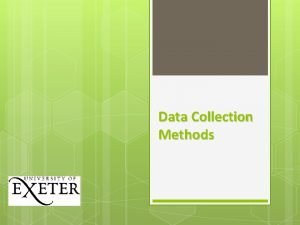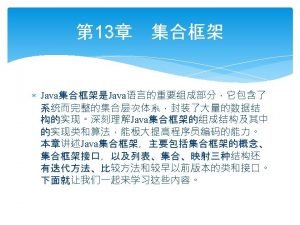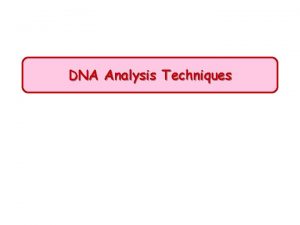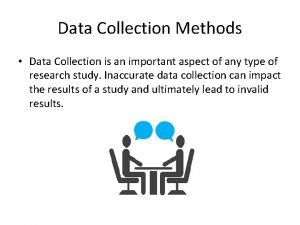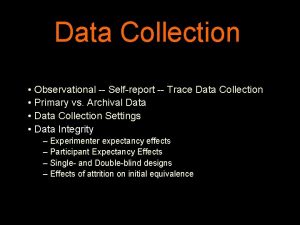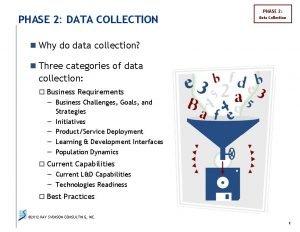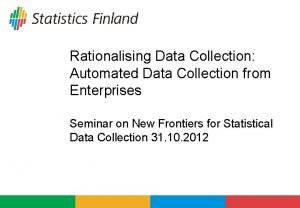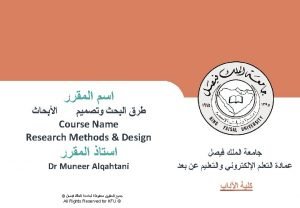Collection of Data The techniques of data collection
















- Slides: 16

Collection of Data The techniques of data collection is called heuristics Data collection is concerned is with three aspects 1. Work identification of place 2. Data identification 3. Classification of the data.

Classification of data (sources) Sources are classified into two types (i) Primary (ii) Secondary Primary Sources Primary sources are unpublished original material, contemporary records, journals, official transactions, minutes, proceedings, private letters, Archeological evidences, inscriptions, coins, literary evidences, foreign accounts, Folklore, ballads Secondary sources are published work in material form like books, journals, and later works.

Work Identification of data Most of the primary sources were available in State Official record repositories called Archives. In archives a researcher can get original records about an events, important statesmen, administrators, government policies etc Popular Archives: Government Archives 1. British Record Office, London, India Record office London, National Archives, New Delhi, Regional Archives in states. Institutional Archives: 1. Jesuit Archives in Senbagnur (Kodaikannal) 2. DRM Railway Archives Trichy 3. AIR Sound Archives Trichy

Preparing Bibliography • Preparing bibliography gives a research scholar an idea of the range of materials on the subject. • The bibliography work is a continuous process. It requires periodic addition. • A bibliography is prepared by using the card catalogues system like indexes used in libraries • Here also a scholar should use the card system. • Copy each title on a separate card generally 3 x 5 inches, keep these cards in alphabetical order • different kind of bibliography would be required from that of area of research history

Bibliography means is a list of the books referred to in a scholarly work. The Relevant Sources are listed. In writing bibliography certain principles are formulated for the citation of sources. Reference to Published Work. 1. Name of the Author starts with Intials, 2. Title of the Work(Italic), 3. Volume Number & Part(if any) 4. Publishers name, 5. Place of Publication, 6. Year of Publication, 7. Page number.

Ex. To Reference to Published Work 1. V. A. Smith, Catalogue of the coins in the Indian Musuem, Oxford, 1906, p-131 2. B. N. Mukherjee’s, Commentary on H. C. Raychaudhari’s Political history of Ancient India, 8 th Edn, New Delhi, 1996, pp-592 -6

Reference to an Unpublished Thesis 1. 2. 3. 4. 5. 6. Name of the Author with Initials, Title of the Thesis, (with in Quotations) Degree for which thesis was submitted, Name of the University, Year of Submission, Page number.

Ex. Reference to an Unpublished Thesis 1. Sanjukta Das Gupta, ‘ A middle Indian Tribe in Transition: The Ho of Singbhum, 1831 -1932’, Ph. D. thesis, Calcutta University, 2006, Chp. 2, p-22 2. K. Chandran, ‘Working Class Movement in Kerala’, Ph. D. Thesis, M. K. University, Maduari, 1990, p-273

Reference to an Article 1. 2. 3. 4. 5. 6. 7. Name of the author(contributor) with Initials, Title of the article, (in Double Quotations) Title of the Journal, (Italic) Serial Number, Place, Year of Publication, Page Nunber.

Ex. Reference to an Article 1. Iqtedar Alam Khan, “ Middle Class in Mogul Empire”, The Proceedings of the Indian History Congress, Aligarh Session (Aligarh, , 1975), p-50 2. M. Rama Rao, “ Religion in Ancient Andhradesa”, Oriental Journal, VOL. VII, (Kavali, 1964), pp 50 -55

Reference To Inscriptions 1. 2. 3. 4. Name of the Source(add if any editor name mentioned), -Italic Source location in brackets, Number of Volume, Number of Plate or pages

Ex. Reference To Inscriptions 1. Inscriptions of the Vakatakas, corpus Inscriptionum Indicarum, Vol. V, ( Archaeological Survey of India, Ootacamund, 1965), p-22 f 2. H. Krishna Sasatri, ed, South Indian Inscriptions, (Manuscript Library, Madras), Vol-II, plate-6

Reference to Archival Sources 1. Name of the Document, 2. Number of the document/file, 3. Date of the document issued, 4. Page number, 5. Place of source Location.

Ex. Reference to Archival Sources 1. Home Political Deposit, File no. 21/ File nos 242 -249, May 1918, p-96, (National Achieves of India) 1. Public, G. O. 342, 18/4/1918, p-4(Tamil Nadu state Achieves)

Reference to Letter 1. 2. 3. 4. Name of the person who wrote, To whom it was written, Place and date Present location of citation

Ex. Reference to Letter H. Harrison, Letter to War department, Indian Affairs, Vol. IV, 18 th November, 1786, NAI
 Research instruments example
Research instruments example Projective techniques of data collection
Projective techniques of data collection Landsat collection 1 vs collection 2
Landsat collection 1 vs collection 2 D/a 30 days
D/a 30 days Fonctions et solutions techniques
Fonctions et solutions techniques Hát kết hợp bộ gõ cơ thể
Hát kết hợp bộ gõ cơ thể Bổ thể
Bổ thể Tỉ lệ cơ thể trẻ em
Tỉ lệ cơ thể trẻ em Chó sói
Chó sói Chụp tư thế worms-breton
Chụp tư thế worms-breton Chúa yêu trần thế
Chúa yêu trần thế Các môn thể thao bắt đầu bằng tiếng đua
Các môn thể thao bắt đầu bằng tiếng đua Thế nào là hệ số cao nhất
Thế nào là hệ số cao nhất Các châu lục và đại dương trên thế giới
Các châu lục và đại dương trên thế giới Công thức tiính động năng
Công thức tiính động năng Trời xanh đây là của chúng ta thể thơ
Trời xanh đây là của chúng ta thể thơ
